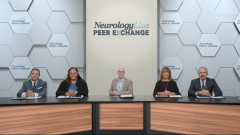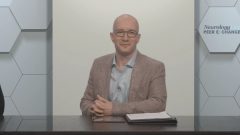
Treatment Interruption and Cessation for Multiple Sclerosis
Stephen Krieger, MD; Daniel Bandari, MD, MS; Bruce Hughes, MD; Mitzi Williams, MD; and Heidi Crayton, MD, review data on short-term interruption of ponesimod vs teriflunomide when treating multiple sclerosis.
Episodes in this series

Stephen Krieger, MD: One of the points that many of you made is that when we stop, for instance, the newer generation of SP1 [sphingosine-1-phosphate receptor]modulators, they come out of the system pretty quickly. And so, one of the concerns I’ve had and that many folks have had in our field is with our cell trafficking blockers, like the S1Ps or even natalizumab, withdrawing those medicines has historically been associated with the risk of rebound MS [multiple sclerosis]. That we take away the cell trafficking inhibition, all of those cells are still in the system, and then they can get to where we don’t want them to go and cause new MS lesions. Rebound had been seen with natalizumab, with fingolimod. That concern has hung over the second generation of S1P modulators, the more selective ones. But now we’re finally starting to see some data that I find a bit reassuring in that respect. Dr Crayton, would you like to talk a bit about newer data on cessation or pausing treatment with either ozanimod or ponesimod and what those data look like?
Heidi Crayton, MD: I think we are reassured by our newer generation of S1P receptor modulators in that they don’t drop the cell counts as low as we are used to seeing with fingolimod. And I think because of that, we don’t see the rebound that we almost became familiar with, with fingolimod. We see that to a much less degree. I have not experienced that at all like I have with fingolimod, so I think that certainly has to bring us some comfort.
Stephen Krieger, MD: I think data that are being presented at ECTRIMS [European Committee for Treatment and Research in Multiple Sclerosis] annual meeting speaks to that, the relatively low incidence of this resurgence of MS disease activity. So, in these pivotal trials, there can be pauses in their treatment as one goes from the pivotal trial into the extension trial. That has been true for several of our studies. In the interruption of ponesimod vs teriflunomide, at the end of their core study OPTIMUM, before the extension, they looked to see what the relapse risk was in that interval. This is presented here by Fred Lublin, MD, and colleagues at ECTRIMS. There’s also another paper on this by Ludwig Kappos, MD.
My takeaway is that the relapse rate during that break, A, wasn’t particularly high, and B, it didn’t seem higher for the ponesimod-treated patients than the teriflunomide-treated patients. And we don’t think that rebound happens when you stop teriflunomide, so it was nice to see something comparable to that, at least that was my takeaway from those presentations here. Dr Bandari, was that similar to your take on the data or your take in practice?
Daniel Bandari, MD, MS: That’s a great point you brought up because this poster was presented yesterday, and I was able to take a look at it and talk to Fred about that. The intriguing part is exactly what you mentioned because we have this historical thought process that with fingolimod, it’s OK to stop and pause the medication and start it after for multiple reasons. But do we have a similar element with a higher efficacy medication such as ponesimod? His data proved that is the case, that there were different circumstances causing a patient to pause and restart the medication. One of the greatest things about it was the fact that a lot of these patients did not have any clinical disruption into that part, no increase in the relapse rates, or progression of disability was seen in that. In clinical practice, I have seen the exact same thing. So, I can attest to the fact that in my patient, I had to do the same thing very frequently for ponesimod. I have not seen much of a clinical presentation in that interruption time.
Stephen Krieger, MD: Dr Williams?
Mitzi Williams, MD: I haven’t seen that either, and I think it’s very reassuring, particularly for our patients in the real world because things happen. There may be a transition of insurance. There may be issues with getting medication renewed, and people can become very frightened if they miss 1 dose of their medication. And so that reassurance that there can be interruption, not intentional in most cases in the real world, but there can be an interruption, and there’s assurance that you can remain clinically stable, I think is extremely important for our patients.
Stephen Krieger, MD: These 2 presentations here at ECTRIMS, in the Kappos presentation, the post-treatment gap was about 17 days. I think in Dr Lublin’s presentation, it was 15 or 16 days. So, these are a couple of weeks off of a current generation S1P without seeing this flare-up of disease, which could allow us to counsel our patients that yes, we don’t want their medications interrupted, but we don’t want to get the panicked phone call if it’s been a weekend and they didn’t get their treatment.
Daniel Bandari, MD, MS: Again, I think one of the key points that you mentioned is being mindful of the fact that a molecule such as ponesimod, we have always talked about the short half-life of it, that within 1 week the drug comes out of the system. So, being mindful that despite that, still the patient did fine.
Transcript edited for clarity
Newsletter
Keep your finger on the pulse of neurology—subscribe to NeurologyLive for expert interviews, new data, and breakthrough treatment updates.






























